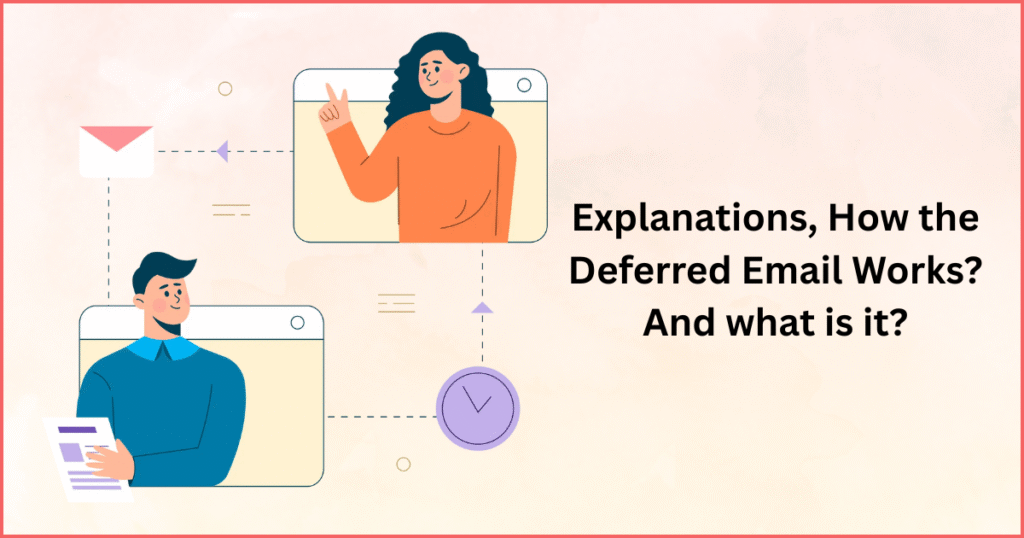Explanations, How the Deferred Email Works? And what is it?
Deferred Email is a term used in reference to any email that has been temporarily put on hold by the recipient’s email server. Therefore, this is not something that the sender does purposely; instead the receiving server’s response happens due to various reasons. Basically, what happens when it comes to deferring an e-mail is like when you call somebody and hear busy signal on their line. This means that at that moment they can’t receive it. Such kind of deferral does not mean e-mail failure; Actually, it’s just using time as an excuse for time wasting. The sending server shall usually wait for some time before attempting once more the transmission of an e-mail message. Delayed Emails’ Causes Understanding email deferment is essential in e-mail marketing for the success of high delivery rates and good image among providers of e-mail services. How Delayed Emails Work As an email message is sent, it passes through several different places, including the sender’s computer and email server before landing in your inbox. This inter-personal relationship is governed by rules and instructions. Here are its stages: 1) Initiating mails: When you send a mail, it goes through your own mail provider ( the server responsible for sending out mails) first. After that this one communicates with the receiver’s own person’s mail provider to deliver your message. 2) Basic interaction: The sender’s operator logs onto the receiver’s operator whose conversation starts based on Simple Mail Transfer Protocol (SMTP), which is also considered a regular standard when transporting mail able items like emails. 3) Deferred Response: The mailing server of the recipient may be faced with temporary challenges to which it is forced to give a reply and this is what causes the deferral as opposed to just taking in the mail for delivery. This is normally an SMTP replay that carries a particular code for example, 4XX status code that symbolizes an interim mishap. 4) Reasons for Deferral: 5) Retransmit: 6) The Length of Retry Attempts: The amount of time during which an email sender’s machine will keep trying to send mails can differ. Generally, it covers approximately between 24 and 48 hours but can be much longer as per policies set by the servers involved. 7) Final Outcome: 8) Monitoring and Management: What is the purpose of Deferred Emails? When we first hear about deferment of emails it sounds rather annoying but there are actually many advantages and different situations where they could be used in email communications and marketing. This paper will outline these benefits with scenarios of their use: 1) Enhanced Email Deliverability When email servers delay messages in times of high volume or whenever problems arise, they remain more effective and stable which helps in ensuring that emails are received better by the general public. 2) Protection from Spam Spam is thwarted via deferral. Frequent postponements of an email sender indicate them changing their behaviour hence keeping email clean. 3) Server Load Management Email servers manage their load more efficiently through peak-time holding incoming emails as this prevents crashes and makes them run smooth. 4) Enhanced Sender Reputation Regularly monitoring and responding to deferred messages can help senders keep or actually improve their email reputation as it promotes good email sending habits. 5) Increased Email Engagement When emails are deferred, they are likely to be noticed and opened by recipients when sent at less busy time’s hence increasing engagement rate. Guide to Deferring E-mail Management It’s important to manage deferred emails properly so that your messages can reach their appropriate destinations and you can keep a good reputation as a sender. Try these approaches: Analysing and Modifying Deferred Emails First thing’s first: understanding why a message was deferred is crucial. This information is usually indicated in a reply sent through SMTP by the receiving server. Some common reasons include an overloaded server, spam suspicion or even technical hitches. Notify me should the following become unclear: If there is anything I need to clarify, please let me know. After determining the reason behind it, check the email itself for components that can activate junk mail filters such as some phrases or overuse of hyperlinks. In addition, ensure that your email looks formal and balanced and frequently remove out dated or incorrect email addresses from your database. You may also segment your list by aspects such as interest level or area, so as to lessen how much mail is sent out at once. Observation of Dispatching and accepting The employment of email analytics is crucial. These analytical tools provide insights on delivery, open rates, and click-through rates, revealing patterns for deferred mails. By creating alerts for deferral emails, an initiative may be taken instantly. Monitoring the performance of deferred emails relative to active ones is also important, as it may influence your overall strategy for email campaigns. Tackling Problems and Mistakes If you receive a notification about a deferral, look into it straight away. Determine whether the email server is properly configured, including authentication protocols such as SPF, DKIM, and DMARC. It is also useful to have feedback loops with major internet service providers (ISPs), which can alert you when recipients label your message as junk mail so that you can fix it quickly. If the same thing happens repeatedly, think of reaching out to your Email Service Provider (ESP) for help. Exact advice and help can be provided by themFurthermore, keeping up with the latest e-mail best practices is important as well. This means that you need to honour opt-outs requests without delay and ensure content relevance and engagement. When it comes to time-sensitive messages, having another e-mail provider or alternate means of communication can be a blessing. In this way, you can make it easier for your emails to get delivered successfully, build your sender’s credibility, and make sure that your communication gets to its intended audience. Deferred Emails Alternative Approaches In order to improve the send ability and manage timing of your email communications when handling deferred emails a





